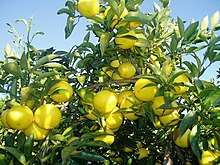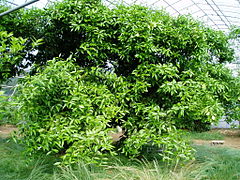Shonan Gold
| Shonan Gold (湘南ゴールド) | |
|---|---|
 | |
| Hybrid parentage | Citrus flaviculpus hort. ex Tanaka (Ōgonkan) × Citrus unshiu (Swingle) Marcow. cv. Imamura unshiu |
| Cultivar | Shōnan Gold |
| Origin | Kanagawa Agricultural Technology Center (神奈川県農業技術センター), Japan |
Shonan Gold (湘南ゴールド) is a hybrid Japanese citrus, with a characteristic "golden" bright yellow color.
Though not completely seedless, the seeds are few in number.[1] The yellowness is inherited from its mother plant (seed parent), a small-sized variety known as Ōgonkan or "Golden Orange", which has been crossed with the Imamura unshiu variety of satsuma orange for size and other desired traits. The cultivar was developed by an agricultural experiment station run by the Kanagawa Prefecture.[1][2]
History
[edit]
Shōnan gold was first cultivated in 1988, by hybrid crossing the Citrus flaviculpus (Ōgonkan (黄金柑, "Golden Orange")) with Citrus unshiu cv. Imamura unshiu (今村温州) (a variety of Satsuma orange).[1][2][3] It is thought to be a nucellar seedling of the mother plant Ōgonkan.[1]
The cultivation was first conducted at the Kanagawa Agricultural Research Institute, Nebukawa Experiment Station (神奈川県農業総合研究所根府川試験場) in the city of Odawara,[2] although the station has since been bureaucratically reorganized as the Nebukawas Sub-Office, under the Ashigara-ku Office, Kanagawa Agricultural Technology Center (神奈川県農業技術センター足柄地区事務所根府川分室).[4] Further seed selection and propagation was continued until the 12th year (1999) to establish stability of characteristics.[2][5] The hybrid was registered with the name "Shōnan Gold" (registration number 11469) at Japan's Ministry of Agriculture, Forestry and Fisheries (MAFF) in 2003,[1][2] and the first harvest took place that same year.[6] Shipment started in 2006 (FY2005) with about 2.0 metric tons officially entering the market,[7] or about 450 kg according to a newspaper coverage.[5][a]
Description
[edit]The sphere-shaped fruit averages about 77 g (2.72 oz) each in weight and the rind or peel is yellow.[1] The flesh or pulp is tender, succulent, and sweet,[1] with sugar concentration typically 11–12 °Bx (i.e. 11–12% by mass).[6] It is fragrant like the Ōgonkan, but is smoother-skinned and easier to peel by hand.[1] The fruit ripens during April and retains excellent flavor until May,[1] which exactly targets the months when the unshū (satsuma) oranges run scarce in the Japanese market.[6]
Cultivation
[edit]
The young sapling is thorny and grows upright, but as it ages, it loses its thorns and begins to spread its limbs laterally.[1] To encourage earlier fruiting, it is important to train the branches on the young tree so they fan out.[1] Fruiting is bountiful, but has alternate year bearing (biennial bearing) tendencies.[1]
The growers (the JA-kanagawaseisho (かながわ西湘農業協同組合), i.e., the Japan Agricultural Cooperatives of the "West Shōnan" region of Kanagawa) and the agency (Kanagawa Agricultural Technology Center) jointly held a symposium on the proper method of fruit thinning and planted a test tree, to continue to develop improved cultivation techniques and quality.[8]
Crop yields
[edit]The history of planted acreage, annual yields, and shipments, according to the agriculture ministry data are tabulated below.[7][9]
In statistics up to 2010, Kanagawa prefecture accounted for 100% of Shonan Gold production in Japan.[b] The major producers are the city of Odawara and the town of Yugawara.[7]
| FY | Acreage | Crop yields | Shipments |
|---|---|---|---|
| 2005 | 0.9 ha | 2.2 t | 2.0 t |
| 2006 | 0.9 ha | 2.2 t | 2.0 t |
| 2007 | 2.7 ha | 8.8 t | 8.0 t |
| 2008 | 3.7 ha | 11.0 t | 10.0 t |
| 2009 | 3.9 ha | 31.1 t | 30.0 t |
| 2009 | 3.9 ha | 31.1 t | 30.0 t |
| 2010 | 5.7 ha | 41.6 t | 40.0 t |
The year is fiscal year, so the first shipment, given as FY2005 in the above data, really occurred in 2006. According to an Asahi Shimbun online edition, the first shipment amounted only to 450 kg (990 lb).[5][a]
Gallery
[edit]-
Original propagating stock tree
-
Blooming
-
Fruition
-
Packing
-
Here you have a lot
Explanatory notes
[edit]Notes
[edit]- ^ a b c d e f g h i j k l Manago et al. 2004
- ^ a b c d e 農林水産省 (MAFF). "Shonan Gold (Registration Number 11469)". 登録品種データベース (Registration kind database). Retrieved 21 February 2013.[permanent dead link] (Also available in English, with limited information. Perform Search for Varieties under PVP Archived 2013-02-04 at the Wayback Machine)
- ^ 真子, 鈴木 & 浅田 2000, pp. 370–1
- ^ 神奈川県農業技術センター(Kanagawa Agricultural Technology Center) (2011-11-10), かながわ農林水産100の知識 (Kanagawa Nōrinsuisan 100 no chishiki), archived from the original on 2014-04-15, retrieved 21 February 2013 農業(15~97頁) Archived 2012-10-18 at the Wayback Machine, p.70
- ^ a b c 楠田裕司(Yuji Kusuda) (2008-04-11). "【神奈川】新種ミカン食後にいかが (Kanagawa-ken: mikan shokugo ni ikaga)". Asahi Shimbun. Archived from the original on 2008-04-15. Retrieved 2008-04-17.
- ^ a b c 神奈川県農業技術センター (Kanagawa Agricultural Technology Center) (December 2007). "湘南ゴールド (Shōnan Gold)". Retrieved 2008-04-11.[permanent dead link]
- ^ a b c 農林水産省(MAFF). "特産果樹生産出荷実績調査 ("special produce orchard tree production and shipment realization study")". Retrieved 21 February 2013.
- ^ かながわブランド振興協議会 (Kanagawa brand promotion council (2012-07-20). "湘南ゴールドのシンニング(摘果)作業を勉強してきました! (Went to study fruit-thinning tasks for Shonan Gold!)". かなさんの畑 (Kana-san's Field). Archived from the original on 2015-06-21. Retrieved 2012-09-05.
- ^ 果物ナビ (Navi fruit). "果物統計 果物別グラフ 湘南ゴールド (kudamono tōkei.. Shōnan Gold)". Retrieved 2012-10-27.
References
[edit]- with English abstracts
- 真子, 正史; 鈴木, 伸一; 鈴木, 誠; 浅田, 真一 (2004). カンキツ新品種'湘南ゴールド. 神奈川県農業総合研究所報告 (in Japanese). 145: 35–41. JGLOBAL ID:200902245650237565. (w/English title and abstract) Agriknowledge (with PDF link); Agri-kanagawa (pdf)[permanent dead link]
- =Manago, Masafumi; Suzuki, Sin-ichi; Suzuki, Makoto; Asada, Shin-ichi (2004). "Kankitsu shin hinshu shōnan gōrudo (A New Citrus Cultivar 'Shonan-gold')" (agris). Bulletin of the Kanagawa Prefectural Agricultural Research Institute). 145: 35–41. ISSN 0388-8231.
- Japanese only resources
- 真子, 正史 (Manago, Masashi); 鈴木, 伸一 (Suzuki, Sin-ichi); 浅田, 真一(Asada, Shin-ichi) (2000). 「黄金柑」より大きく,果皮の滑らかな,さわやか味のかんきつ新品種「湘南ゴールド」. 研究成果情報 果樹・野菜-花き・茶業・蚕糸 関東東海農業 (in Japanese): 370–371. JGLOBAL ID:200902108737806836. Retrieved 21 February 2013.
{{cite journal}}: CS1 maint: multiple names: authors list (link)- ="'Shōnan Gold,' a new type citrus larger, smoother-skinned, and refreshing tasting than ōgonkan", in: 'Kenkyū seika jōhō vol./year 2000, p. 370-1)
External links
[edit] Media related to Citrus 'Shonan Gold' at Wikimedia Commons
Media related to Citrus 'Shonan Gold' at Wikimedia Commons





